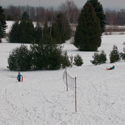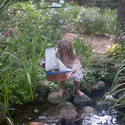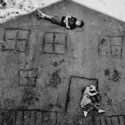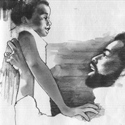So there was this guy in ancient Rome called Germanicus. He had a bunch of other names too but if we get into that we'll have to try to wrap our head around how nearly every potential successor to Augustus was somehow the nephew of the adopted first son of his third wife and also the grandson of his sister and Marc Antony or something plus a dozen other connections and by then you're so grossed out and confused you don't care about any of them anymore. He was called Germanicus because his family was all about going to Germany and kicking ass. If I remember my Tacitus, the tribes of Germania at this time were a disgusting lot whose menfolk (when not fighting each other) sat around wearing nothing but cloaks held together with thorns while their wives brewed the beer and cleaned the hovels and worked the fields, and when they were fighting each other they took their wives with them to bare their breasts on the sidelines so the men would be reminded of how their wives would be hauled off somewhere if they lost. These jerks had been doing a pretty amazing job of keeping the Romans south of Rhine until Germanicus' dad Drusus came along and mopped up Germans everywhere he went until he fell off his horse and died. Germanicus grew up to lead his dad's legions on many successful campaigns against those half-naked, misogynistic hornhats. Everyone in Rome loved Germanicus, which is why everyone suspected the emperor and his creepy friend Sejanus had him poisoned while he was off in Asia. Germanicus' son Gaius would accompany him on military campaigns in Germania where the little boy was beloved by all his father's soldiers. According to the historian Suetonius, whenever the troops would get all drunk and angry over their cracker rations or something, "the mere sight of [the child] Gaius unquestionably calmed them." It was said that Germanicus had a full Roman military kit made for the boy so he looked just like a common soldier, including a pair of the common soldier's hob-nailed military boots, called caliga. The soldiers called him Caligula, meaning "Little Boots." Maybe you've heard of him? I think the guy who started Penthouse Magazine made a movie about him once.
That is one of my wife's favorite stories from her days of high school Latin. Her other favorite Latin memory is that our word scruple comes from the Latin word scrupulus, (which literally meant "a small sharp stone,") and was used figuratively by Cicero to mean "a feeling of doubt or reluctance to do something that one thinks may be wrong." A nagging feeling, like a small annoying stone trapped in your little boots.
I am not wholly without scruples. There were times, while sitting down at the playground working on a full, authentic Roman soldier's kit for my own son when I wondered if maybe I was taking things a bit too far. After all, look how it worked out for young Gaius. But apparently that didn't stop me. The only part of this costume that I did not make myself from scratch were the sandals. I added leather straps to some sandals we already owned, and although I certainly wanted to craft a pair of hobnailed little soldier caliga, I couldn't. Going that far just seemed unscrupulous.
I don't have it in me to be a homeschooler, but this summer I've been teaching the kids all about ancient Rome. We've been reading tons of books and playing with Roman soldier toys and even watching old Asterix cartoons. My boy has taken to it as enthusiastically as any other subject involving heroes with armor and edged weapons (plus giant communal toilets with "sponges on a stick" instead of toilet paper). He really loved my description of Roman fermented fish gut sauce. Sometimes I nerd out a bit too much. We'll be talking about Julius Caesar and how he was stabbed to death by his friends and my son will call him "the Roman king" and I roll my eyes and remind them that Romans hated kings, that his friends killed him because he started acting like a king and that Romans were like us in that they did not believe in giving one person too much power, and then I'm ranting about how ultimately the Romans did create something way worse than a king, a man so powerful that kings and Pharaohs and satraps and chieftains all bowed before him. Sometimes emperors even believed that they themselves were gods." And then he's like, Whatever dad. When can I throw my spear again? And then I'm all, "When you've learned the Latin words for all your weapons." And then he's like, "Here's a pilum in your gut, Cicero."
I majored in Latin because I loved all this stuff. Even after the tedium of conjugating a thousand irregular verbs you knew you were still learning about some untouchably Romantic time in Western history, full of conquering generals and political intrigue and feasts of peacock and honey-dipped dormice and stones and stories that would hold together for thousands of years. I've had so much fun talking about the history I loved as a kid with my own kids, and I've loved bringing it to life for them. It all started with a trip to the art museum. By now we know every piece in the museum's classical collection, and this armored torso has always been one of our favorites:
Common Roman soldiers didn't wear armor like this---it would have been mostly decorative and worn by generals and patrician officers. But I really wanted to carve those two griffins eye-to-eye with that gorgon's head in the middle of a cuirass. I drew the griffins freehand on tracing paper and folded it in half so they would be mirror images, then I traced it with a ballpoint pen over a piece of leather cut to the shape of the armor.
With the design on the leather, I began carving and stamping it so it would stand out.
After that, it was just a matter of wetting and shaping the leather over a mold and letting it dry to the proper shape.
Then I dyed it reddish-brown, applying several more coats over the designs to make them stand out even more. The skirt I did the same way. I considered making it all one piece but they like to mix and match their costumes so I thought I'd give them that option with this one too.
If I had been truly historically accurate, I probably would have made the helmet in the Attic style with a forward-facing crest, but he really liked the centurion's helmet so I sewed together a helmet in the Gallic style and added the crest which came from the bristles of an old broom. I had never made a leather helmet before so I looked at how a baseball hat was made and just copied it without the brim, then sewed the extra pieces on where I needed them. This was great fun, probably because my wife didn't think I would ever be able to do it.
Seeing him in that helmet with that crest makes me so happy.
His throwing spear (pilum) is a leather tip attached to a dowel driven into a shaft of scrap walnut.
The sword (or gladius) I modeled on some surviving examples and used walnut for the blade and tang, then glued-on pieces of cherry for the handle.
I also made him a soldier's dagger (or pugio) from the same walnut with a handle made from some scraps of zebra wood.
The scabbards were really fun---both were based on designs from actual archaeological discoveries. The sword's sheath gave me a chance to learn how to do some metal engraving. I did not dye these sheaths---the leather turned that color after multiple coats of molten beeswax, which also hardened them to the point where they're no longer flexible.
The design I painted on the front of the shield includes several motifs from shields in relief sculptures, like Trajan's column. The shield boss is a plastic bowl epoxied to a sheet of steel and painted.
See previously: Epic Fun

















































